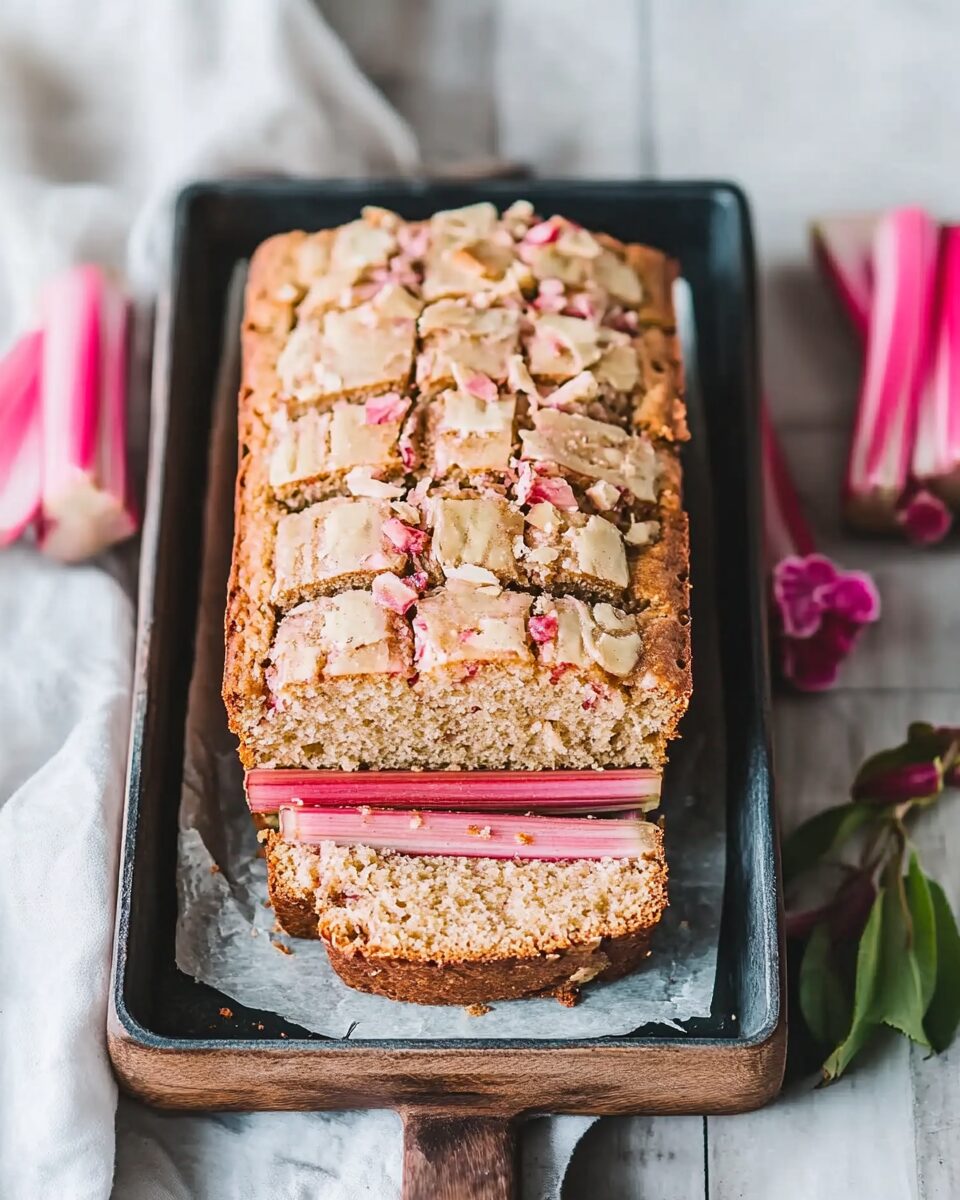Celebrate the vibrant flavors of spring with this delightful Rhubarb Bread. Crafted with hearty oat flour, crunchy walnuts, and tart rhubarb, this quick bread offers a moist, tender crumb that’s both wholesome and satisfying. Naturally gluten-free and lightly sweetened with raw honey, it’s a perfect treat for breakfast or a midday snack.
Full Recipe:
Ingredients
- 1 egg
- ½ cup unsweetened almond milk
- ¼ cup + 2 tablespoons raw honey
- 3 tablespoons melted coconut oil
- 1 teaspoon vanilla extract
- 2 cups oat flour
- 2 tablespoons sweet rice flour
- 1½ teaspoons baking powder
- 1 teaspoon baking soda
- ½ teaspoon salt
- 1 teaspoon cinnamon
- ½ teaspoon nutmeg
- 1½ cups diced fresh rhubarb
- ½ cup chopped walnuts
- 2 tablespoons chia seeds (optional)
Directions
- Preheat your oven to 350°F (175°C). Line a loaf pan with parchment paper and set aside.
- In a small bowl, whisk together the egg, almond milk, raw honey, melted coconut oil, and vanilla extract.
- In a large bowl, combine the oat flour, sweet rice flour, baking powder, baking soda, salt, cinnamon, and nutmeg. Mix until well combined.
- Pour the wet ingredients into the dry ingredients and stir until just combined. Avoid overmixing to prevent a gummy texture.
- Gently fold in the diced rhubarb, chopped walnuts, and chia seeds (if using) until evenly distributed.
- Transfer the batter into the prepared loaf pan. For an optional decorative touch, place thin slices of rhubarb on top of the batter.
- Bake for 45–50 minutes, or until a toothpick inserted into the center comes out clean and the top is lightly browned.
- Remove from the oven and let the bread cool in the pan for 10 minutes. Then, using the parchment paper, lift the bread out of the pan and place it on a cooling rack to cool completely before slicing.
Nutritional Facts
- Serving Size: 1 slice (1/10 of the loaf)
- Calories: 247 kcal
- Carbohydrates: 30g
- Protein: 7g
- Fat: 11g
- Saturated Fat: 4g
- Polyunsaturated Fat: 6g
- Cholesterol: 19mg
- Sodium: 318mg
- Fiber: 3g
- Sugar: 4g
The Unique Flavor Profile of Rhubarb Bread
The standout ingredient in rhubarb bread is, of course, rhubarb. Rhubarb has a distinctive tartness that is unlike any other fruit or vegetable. While it is technically a vegetable, rhubarb is often treated as a fruit in cooking and baking due to its acidic and fruity flavor. Its flavor is bright and refreshing, making it perfect for spring recipes where fresh, seasonal ingredients are key.
In rhubarb bread, the tartness of rhubarb is balanced by the natural sweetness of honey and the richness of coconut oil. These ingredients create a harmonious flavor profile, where the tangy punch of the rhubarb contrasts beautifully with the sweetness, resulting in a loaf that is both comforting and invigorating. The addition of cinnamon and nutmeg provides a warm, cozy undertone, adding to the overall appeal of the bread.
The Health Benefits of Rhubarb Bread
One of the greatest things about rhubarb bread is that it’s a treat that’s both delicious and nutritious. Rhubarb is low in calories and rich in vitamins and minerals, particularly vitamin K, which plays a crucial role in bone health and blood clotting. It also contains significant amounts of fiber, which is beneficial for digestive health, and antioxidants that help combat inflammation and protect cells from damage.
The inclusion of walnuts adds another layer of health benefits to this bread. Walnuts are an excellent source of healthy fats, particularly omega-3 fatty acids, which are known to support heart health and reduce inflammation. They also contain a variety of vitamins and minerals, including vitamin E, magnesium, and copper, all of which contribute to overall well-being.
Additionally, the use of oat flour in this bread makes it a more wholesome choice compared to traditional wheat flour-based baked goods. Oat flour is naturally gluten-free, making this recipe a great option for those who have gluten sensitivities or follow a gluten-free diet. Oat flour is also a great source of fiber, particularly beta-glucan, which is known for its ability to lower cholesterol levels and support heart health.
Why Choose Rhubarb Bread?
Rhubarb bread is a versatile recipe that can be enjoyed at any time of day. Whether you’re enjoying it for breakfast, as a midday snack, or even as a dessert, it’s a delightful way to incorporate more fruit and wholesome ingredients into your diet. The combination of oats, rhubarb, and walnuts makes it a more nutritious alternative to many other sweet treats, and it can be easily customized to suit your tastes.
One of the best aspects of this recipe is its simplicity. It’s easy to prepare, and the ingredients are simple and accessible. There’s no need for complicated techniques or hard-to-find ingredients—just a few pantry staples and some fresh rhubarb. This makes it an ideal recipe for both beginner bakers and seasoned professionals who are looking for a quick and easy way to create something delicious.
Moreover, rhubarb bread is incredibly adaptable. You can easily swap out ingredients based on what you have on hand. For example, if you don’t have walnuts, you could substitute with another type of nut or even use seeds for added crunch. You can also adjust the level of sweetness by using more or less honey, depending on your preference. The flexibility of this recipe means that you can make it your own, creating a version that suits your unique tastes.
The Importance of Fresh Rhubarb
When making rhubarb bread, the freshness of the rhubarb plays a significant role in the flavor of the final product. Fresh rhubarb has a bright, crisp texture and a vibrant color that adds visual appeal to the bread. It’s important to use fresh rhubarb whenever possible, as frozen rhubarb can sometimes become mushy when baked, altering the texture of the bread.
When selecting rhubarb, look for stalks that are firm and crisp, with bright green and red coloring. Avoid rhubarb that appears wilted, limp, or has blemishes. It’s also important to trim off the leaves of the rhubarb, as they contain oxalic acid, which can be toxic if consumed in large quantities. Only the stalks are edible.
If fresh rhubarb is unavailable, you can use frozen rhubarb as a substitute, but keep in mind that the texture of the bread may be slightly different. If using frozen rhubarb, it’s a good idea to thaw it and drain off any excess moisture before adding it to the batter to prevent the bread from becoming too soggy.
How to Store Rhubarb Bread
Rhubarb bread is best stored in an airtight container at room temperature for up to three days. This helps maintain its freshness and moisture. If you want to extend the shelf life of your bread, you can store it in the refrigerator for up to a week. Just be sure to let the bread cool completely before wrapping it in plastic wrap or placing it in an airtight container.
If you have leftovers that you don’t think you’ll be able to finish in a few days, rhubarb bread freezes well. To freeze, wrap the bread tightly in plastic wrap or aluminum foil, and then place it in a freezer-safe bag or container. When you’re ready to enjoy it again, simply thaw it at room temperature or pop it in the microwave for a quick reheating.
Conclusion
Rhubarb bread is the perfect way to showcase the tart, refreshing flavor of rhubarb while also enjoying a delicious and wholesome treat. With its simple ingredients, quick preparation time, and incredible flavor, it’s no wonder this recipe has become a favorite among home bakers.






